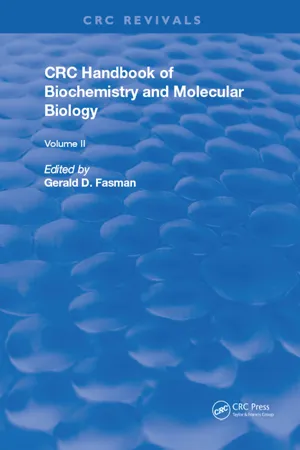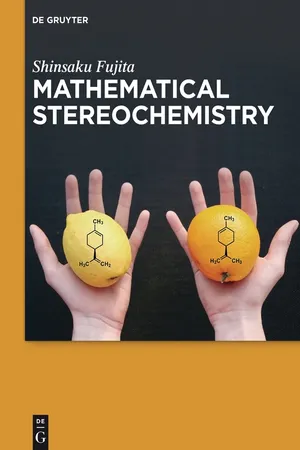Chemistry
Relative configuration
Relative configuration refers to the spatial arrangement of atoms or groups in a molecule compared to a reference molecule. It is used to describe the arrangement of substituents around a chiral center without determining the actual 3D structure. Relative configuration is often represented using descriptors such as R/S or cis/trans to convey the relationship between different atoms or groups in a molecule.
Written by Perlego with AI-assistance
Related key terms
Related key terms
1 of 4
Related key terms
1 of 3
3 Key excerpts on "Relative configuration"
- eBook - ePub
Handbook of Biochemistry
Section A Proteins, Volume II
- Gerald D Fasman(Author)
- 2018(Publication Date)
- CRC Press(Publisher)
Notes: (1) Contrast conformation (Rule E-1.5). (2) The phrase “differ only as after rotation” is intended to make the definition independent of any difficulty of rotation, in particular independent of steric hindrance to rotation. (3) For a brief discussion of views (a) to (c), see Appendix 1. It is hoped that a definite consensus of opinion will be established before these Rules are made “Definitive.”Examples: The following pairs of compounds differ in configuration:E-1.5. Various views are current regarding the precise definition of the term “conformation.” (a) Classical interpretation: The conformations of a molecule of defined configuration are the various arrangements of its atoms in space that differ only as after rotation about single bonds, (b) This is usually now extended to include rotation about π bonds or bonds of partial order between one and two. (c) A third view extends the definition further to include also, rotation about bonds of any order, including double bonds.Molecules differing in conformation are termed conformational isomers.Hence: conformational isomerismNotes: All the Notes to Rule E-1.4 apply also to E-1.5.Examples: Each of the following pairs of formulas represents a compound in the same configuration but in different conformations.E-1.6. The terms relative stereochemistry and Relative configuration are used with reference to the positions of various atoms in a compound relative to one another, especially, but not only, when the actual positions in space (absolute configuration) are unknown.E-1.7. The terms absolute stereochemistry and absolute configuration are used with reference to the known actual positions of the atoms of a molecule in space.*E-2. cis–trans Isomerism†Preamble. The prefixes cis and trans have long been used for describing the relative positions of atoms or groups attached to nonterminal doubly bonded atoms of a chain or attached to a ring that is considered as planar. This practice has been codified for hydrocarbons by IUPAC.** There has, however, not been agreement on how to assign cis or trans at terminal double bonds of chains or at double bonds joining a chain to a ring. An obvious solution was to use cis and trans where doubly bonded atoms formed the backbone and were nonterminal and to enlist the sequence-rule preferences to decide other cases; however, since the two methods, when generally applied, do not always produce analogous results, it would then be necessary to use different symbols for the two procedures. A study of this combination showed that both types of symbols would often be required in one name and, moreover, it seemed wrong in principle to use two symbolisms for essentially the same phenomenon. Thus it seemed to the Commission wise to use only the sequence-rule system, since this alone was applicable to all cases. The same decision was taken independently by Chemical Abstracts Service who introduced Z and E to correspond more conveniently to seqcis and seqtrans - eBook - ePub
- Caroline Cooper, Rupert Purchase(Authors)
- 2017(Publication Date)
- CRC Press(Publisher)
5 StereochemistryJohn BuckinghamStereochemistry of Organic Compounds, ed. E. L. Eliel, S. H. Wilen and L. N. Mander, Wiley, New York, 1994.Nomenclature of Organic Chemistry (IUPAC Recommendations and Preferred IUPAC Names 2013), ed. H. A. Favre and W. H. Powell, Royal Society of Chemistry, Cambridge, 2014.Brecher, J., “Graphical Representation of Stereochemical Configuration (IUPAC Recommendations 2006)”, Pure Appl. Chem., 2006, 78, 1897–1970.Naming and Indexing of Chemical Substances for Chemical Abstracts, 2007 edition, p. 71 et. seq.Stereochemistry deals with the topography and transformations of molecules in three dimensions, that is, the features that go beyond the connectivity (which atoms are joined to which). It is conventional to distinguish between configuration (features that cannot be interconverted without bond breaking) and conformation (different states of the same molecule that can interconvert without bond breaking), but this distinction is not precise. There are some types of molecules (those with bond character intermediate between single and double, biaryls with medium-sized ortho-substituents and so on) where the energy barrier to interconversion from one isomer to another is comparable to their energy content at room temperature. At sufficiently low temperatures, all conformations become configurations.A chiral (handed) molecule is one capable of existence in a pair of non-superposable mirror-image forms. Nearly all configurations now found in the literature are absolute configurations—that is, the handedness or chirality of the molecule in real space is known. This was not possible until the 1950s, so the old literature must be consulted with care. By coincidence, the arbitrary configurations assigned before the 1950s to compounds related to the standard molecules glucose and serine and defined using the oldD ,L - eBook - ePub
- Shinsaku Fujita(Author)
- 2015(Publication Date)
- De Gruyter(Publisher)
7813.1 Absolute Configuration13.1.1 Single Pair of Attributes ‘Chirality/Achirality’ in Modern StereochemistryIn the glossary of the IUPAC Recommendations 1996 [1 ], the term configuration is defined as “In the context of stereochemistry, the term is restricted to the arrangement of atoms of a molecular entity in space that distinguishes stereoisomers, the isomerism between which is not due to conformation differences. See also absolute configuration and Relative configuration”. And then, the term absolute configuration is defined as “The spatial arrangement of the atoms of a chiral molecular entity (or group) and its stereochemical description, e.g., R or S.”The term ‘stereogenic’ has later been proposed to rationalize the foundations of R/S- stereodescriptors [2 ]. Helmchen [3, Section 1.3 ] has pointed out that the term chirality element is one of problematic terms: “This previously common term should be used with care. More appropriate is the term stereogenic unit”. However, Helmchen [3, Table 1] maintains the usage of the terms ‘chirality center’ (C ‘chirality units’) and ‘pseudoasymmetric center’. (C ‘pseudoasymmetric units’). Moreover, Rule 91.1.1.1 of Provisional Recommendations 2004 [4 ] refers to the term ‘stereogenic unit’ and points out the presence of three kinds of stereogenic units (a central atom such as a chirality center, a central bond such as a chirality axis, and a double bond). Then, it states “... A chirality center, formerly known as an ‘asymmetric atom’, is the classical example of a stereogenic unit.” and shows an example of assigning an R-descriptor to a ‘chirality center’ of Xabcd.The term ‘stereogenic centers’ is used to designate a pair of Cl-substituted carbons in cis- and trans-1,3-dichlorocyclobutanes, where interchange of two ligands (Cl and H) at a ‘stereogenic’ center leads to a stereoisomer [5, Fig. 3.8
Index pages curate the most relevant extracts from our library of academic textbooks. They’ve been created using an in-house natural language model (NLM), each adding context and meaning to key research topics.
Explore more topic indexes
Explore more topic indexes
1 of 6
Explore more topic indexes
1 of 4


